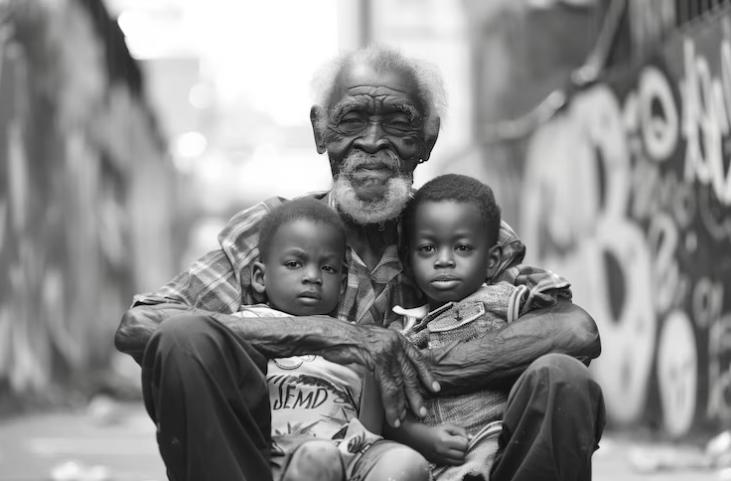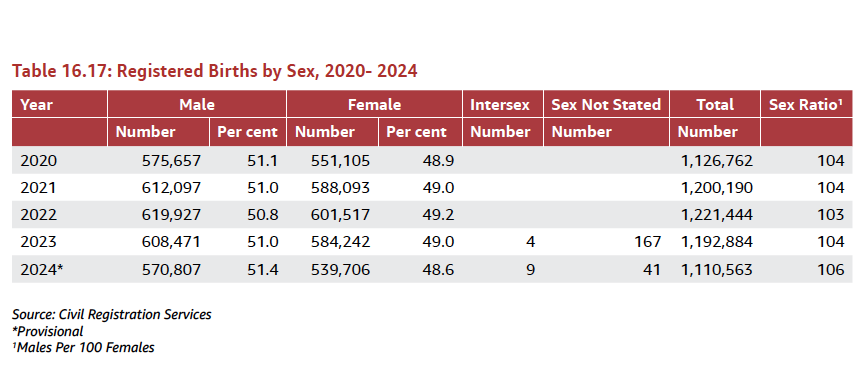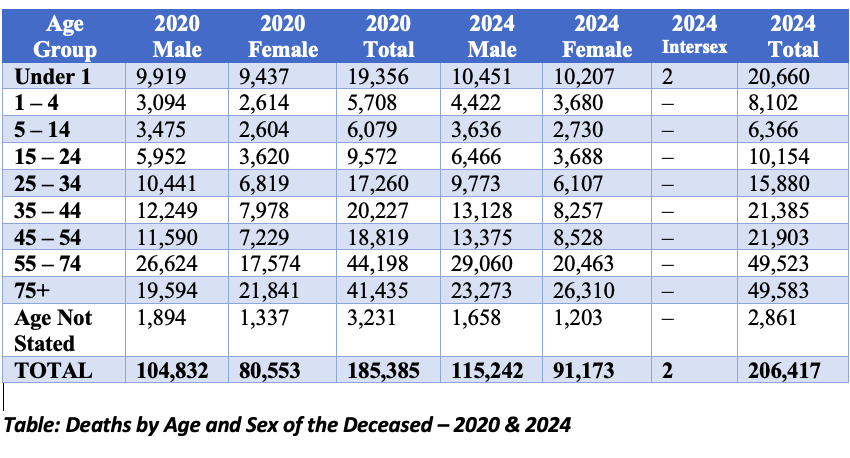 Although more boys than girls are born every year in Kenya, men die sooner and are buried in larger numbers until age 75, the survey indicates.
Although more boys than girls are born every year in Kenya, men die sooner and are buried in larger numbers until age 75, the survey indicates.
In Kenya, the journey from the first cry to the final breath is shaped by more than fate. Men begin in bigger numbers but they also leave sooner and in larger numbers. For women like Anna, the journey lingers on.
The Kenya Economic Survey 2025 maps this lifeline, revealing entrenched inequalities that follows Kenyans until their last breath.
Anna and her future husband Emilio were born in the village in approximately 1950. They have ten grandchildren. The last one was among the 1,110,562 births that the Economic Survey says were recorded last year.
Most of these children (51.4 per cent) were boys, a trend that goes back ten years. Although more boys than girls are born every year in Kenya, men die sooner and are buried in larger numbers until age 75, the survey indicates.
Emilio and Anna* shared a common thread growing up – surviving killer childhood diseases, dropping from school, and abandoning life’s dreams that were perhaps too big for their small villages.
By the ages of five, both had already beaten the odds. In 2024, about 28,762 children (14,873 boys and 13,887 girls ) below five years did not survive, despite the improved healthcare systems, the 2025 Economic Survey says.
Anna was pregnant by approximately age 14 and dropped from school, burning her desire to become a nurse.
 Kenya registered 1.1 million births last year, lower than any other time in the last five years.
Kenya registered 1.1 million births last year, lower than any other time in the last five years.
But the generation of her grandchildren has fared better. Teenage pregnancies have been dropping and last year, only about 10,126 girls aged ten to 14 years were pregnant, half the number of 2021. In total, 241,228 teenagers aged 10-19 were pregnant last year.
“The counties of Nairobi City (6.1 per cent of teenage girls), Kakamega (4.8 per cent), Narok (4.4 per cent) and Bungoma (4.4 per cent) had the greatest proportion of teenagers presenting with pregnancy at their first ANC visit in 2024,” the Economic Survey says.
Emilio became a mechanic after primary school, a job he tenuously did for over three decades. But life took its toll with long work days and few breaks.
By the time he was 60, the years had begun to weigh on him.
Death in Kenya comes knocking more frequently between the ages of 55 and 74, according to the survey, which was released on Tuesday. Last year, the highest number of deaths – for both adult men and women – was recorded after age 55.
The age 55-74 is the peak season for all men. About 29,060 men in this age bracket died in 2024 alone, compared to 20,463 women.
Emilio last day came in the year 2020 when he was aged 70. Chest pains. A rushed ride to the nearby clinic. Silence.

Report shows the number of registered deaths in 2020-2024 according to sex.
He became a number – 1 of the 104,832 men registered dead in 2020. Only 80, 553 female Kenyans died that year, according to the 2020 economic survey.
The 2023 Kenya Vital Statistics Report reported that the four leading causes of death among adults between 2019-2023 (probably even today) are pneumonia, cardiopulmonary and cardiorespiratory arrest, respiratory infections and cancer.
Anna lived on. She turned 70, then 74 in 2024. Women tend to outlive men in Kenya. The data says so.
But the Economic Survey report released in 2020, the year Emilio died, has a different explanation.
The 2020 report noted that part of the disparity in male and female death rate may be due to a higher likelihood of registering male deaths, especially where property inheritance is involved.
“Incentives such as property inheritance may drive families to register the deaths of males more than those of females,” the report stated.
The death data comes from the civil registration services. The 2025 economic survey actually indicates most registered deaths are of married people.
"Among the registered deaths, individuals who were married continued to account for the highest share, rising from 85.4 per cent in 2023 to 86.3 per cent in 2024. In contrast, the proportion of those reported as single declined from 14.2 per cent to 13.4 per cent, over the same period," the survey says.

Anna’s world has grown quieter. In 2024, about 20,463 of her
female agemates (women aged 55-74) died. A higher number of men (29,060) aged
55-74 also died last year.
In total, 206, 417 Kenyans of all ages died last year (115, 242 male and 91,173 female).
But 74 is the last age where more men than women die in Kenya. From here, the tables turn. Women begin to die in larger numbers compared to the few remaining men.
“In 2024, the number of registered deaths was higher among males than females across all age groups except for persons aged 75 and above,” the 2025 report indicates.
And so last year, there were 26,310 registered deaths of women above 75 years, compared to 23,273 deaths of men.
In the end death catches up with everyone.
But the cycle continues. Last year, 570,807 male children
(51.4 per cent of all registered births) were born, compared to 539,706 female babies
(48.6 per cent). And they began another circle of life.
* Emilio and Anna are illustrative characters, created to illustrate the real data and disparities revealed in the Kenya Economic Survey 2025.











